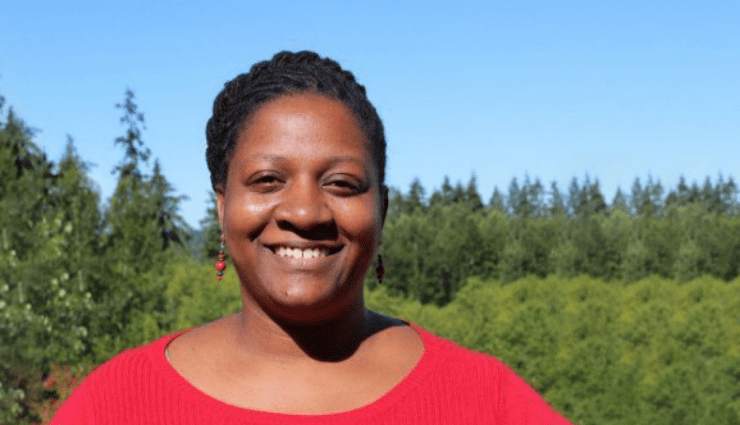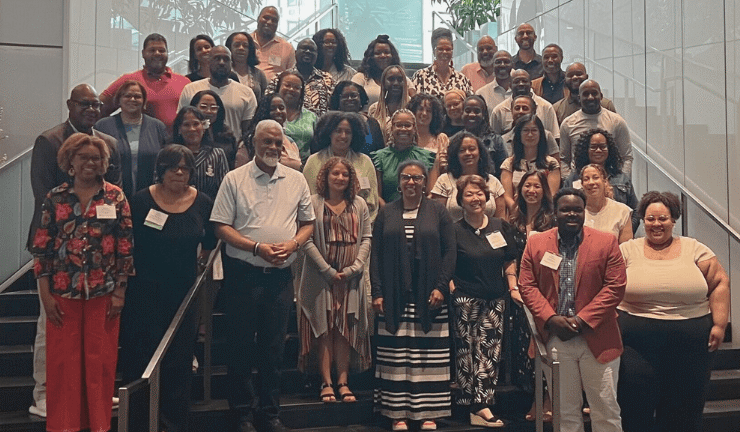Brenda Leaks: My Journey to Headship

If you are a woman of color teaching in an independent school and in the back of your mind you aspire to become a head of school, it’s easy to look at the odds and stop in your tracks. I’m here to tell you don’t stop. Yes, the percentage of women in headship positions is lower than the percentage of men, and the number of heads of color remains in the single digits. So the odds are particularly stacked against women of color. But the world is changing and schools are changing and pathways to headship are widening. More to the point, students, teachers, parents, schools, and, indeed, the world need our leadership now more than ever.
When I was young, I was barely aware of the existence of independent schools. No one in my family had attended one, or any kind of fee-based school. Yet, here I am now, serving as the third head of school at the remarkable Seattle Girls’ School — a young independent school brilliantly designed to serve the needs of girls and gender non-confirming students in their middle school years. Sure, the work is hard, but I love my job and look forward to it each day. I love being in a leadership position that allows me to create the conditions that, in turn, enable our teaching staff to educate our kids well — helping them, as our mission states, to build both the confidence and competence to lead fulfilling lives and champion the kind of societal change that needs to take place in this nation.
If you aspire to school leadership, I’m here to encourage you to stay the course.
A little background. In my elementary schools years in Philadelphia public schools, I got by, but felt more or less invisible. When I moved during my middle school years and started at a new school in a new community, I was suddenly quite visible as the only student of color in the building. This experience came with its challenges, but I’ll forever be thankful to those teachers who saw my inherent worth and chose to encourage me and support me. With their help, and with support from an aunt who guided me during those years, I found myself and my voice. Because of these attentive adults in my life, I engaged deeply in learning and went on to become the first member of my family to graduate from college. I knew I wanted to become a teacher because the formal and informal teachers in my life had inspired me to love learning and to believe in my own strength and potential; and I wanted to be an educator and a mentor who could do that for others.
I began my career in education working with The Breakthrough Collaborative, a nonprofit focused on helping low-income students successfully move from middle school through college. Afterward, I was hired to teach middle school Spanish at The Baldwin School, an all-girls pre-K–12 independent school just outside of Philadelphia. At Baldwin, I also became deeply involved in the school’s diversity and equity work. Two years later, I moved literally across the street to teach middle school Spanish and work as a diversity practitioner at The Shipley School, a co-ed, pre-K–12 independent school.
In all of these positions, while I was deeply focused on the work at hand, I also found myself taking on various leadership roles — which I both enjoyed and had some success. With encouragement from colleagues, I began thinking more formerly about school leadership, which led me to the Klingenstein Center at Teachers College, Columbia University, where I knew I could acquire the needed skills.
After graduating from the Teachers College program in 2006, I moved to Austin, Texas, to become the middle school head at Trinity Episcopal School of Austin, a K–8 independent school. A few years later, I became the middle school head at The Overlake School, a 5–12 coeducational independent school, in Redmond, Washington — a move that would also take me closer to family on the West Coast.
Every step of the way has been valuable to me. Each gave me the opportunity to both test out and strengthen my leadership skills while learning from the leaders with whom I worked. At Trinity Episcopal School of Austin, for instance, the school was very young (founded in 1999) and going through all the complexities of a young start-up school. The school is doing well today, but at the time, I ended up working with four heads of school in three years. Seeing different leadership styles up close proved particularly instructive and helped me understand the challenges young schools face. It also gave me enough insights into leadership that I began to understand that I could, in fact, be a school head and do it well. At The Overlake School, I arrived two years before a longstanding head of school retired and a new, first-time head arrived. I not only got to observe the difference in leadership styles of these two heads but also learned more about what is possible for heads to achieve in their first year of headship versus those who had been in the community for many years.
In the Klingenstein program, as noted, I was steeped in all aspects of school leadership — from budgeting to supervision, from law to marketing and communications, from working with boards to fundraising, from overseeing the curriculum to managing the complexities of community life. This training and information have been extremely valuable to me in the years that followed, but the program also proved essential for the friendships and professional connections I made. This combination of skills and connection have been key in the lead up to headship — and, indeed, in my growth today as a school leader.
To outline my leadership journey in the way I have here makes it seem as if every step was carefully planned and came off without doubt and without a hitch. This is far from the truth. While I’ve always known that I enjoy being a leader in various formal and informal ways, I’ve had plenty of doubts along the way. More than any point I want to make here, this is key. We all have doubts. Life is messy and challenging. It’s fairly easy to feel overwhelmed, especially if one works in schools today. What helped me, and I’m sure will help you, are the connections I’ve made along the way. These are people I can turn to and who can turn to me for encouragement, support, and guidance — or simply as a sounding board so I can hear myself think out loud. These are also the people who stepped up and championed me when I needed it.
I had heard about Seattle Girls’ School when I was still enrolled in the Klingenstein program. The school was looking for an assistant head and I was considering applying. Everything I read about the school made it sound like the ideal fit for me. At the time, however, the school decided to go with an internal candidate. A few years later, I started as the middle school head at The Overlake School just outside of Seattle. I sometimes joke that I moved to the Seattle area in part to stalk the Seattle Girls’ School. That isn’t true. But I did remain deeply interested in the school and its mission.
So… you’d think that when the position for head of school opened up at Seattle Girls’ School I would jump at it immediately. Right? But I didn’t.
Doubts crept in. Is it time to apply for a headship? Am I’m ready? Do I want to make such a drastic change in my life? I was in my sixth year at The Overlake School and felt I had hit my stride and was doing well. I loved the school and my colleagues. My personal life was settled nicely into a solid routine. I even had enough free time to study Chinese at the local community college on the side. Did I want to upend the life that I had worked so hard to create?
It was at this point that I had the fortuitous opportunity to meet Ronnie Codrington-Cazeau, then head of The Evergreen School, now head at University Prep School in Seattle. I had never met Ronnie before, but she was aware of my work and reached out to say she wanted to get to know me. When we met, the first thing she said is, “You are applying to Seattle Girls’ School, right?” It was one of those statements disguised in the form of a question. She wasn’t really asking.
I expressed hesitation and doubts and she walked me through them all — helped me understand that I shouldn’t pass up the opportunity, that at the very least I should apply.
This gentle but firm nudge, this clear expression of support and encouragement, got me over the hump of hesitation. Looking back, it’s possible that I may have come to this conclusion on my own. But I may not have. Ronnie’s support for me, her sense that I not only could do the job but that I was ready to do it and would love it, was pivotal.
And it’s true: I absolutely love my job.
Because of the support I’ve received along the way — literally at every stage of my schooling and professional life — I’ve also made it a priority to do what I can to support others, particularly women of color who are either currently working in leadership positions or are aspiring to leadership. I have worked as a facilitator for Leadership+Design’s Wonder Women program. I’ve taken part as a faculty member in the Northwest Association of Independent Schools’ Pathways to Leadership program. Every time I attend the NAIS People of Color Conference I go out of my way to connect with my mentors and friends while making new connections with educators looking for guidance in their careers. This work in the broader community is as essential as anything I do within my own school.
I am not alone in this commitment. For so many women of color who are heads of school, the work we do within the larger community is essential to our leadership and to the work we do within our own schools. All of us were supported along the way by leaders who challenged us to grow and championed us for increasingly higher positions of leadership. Mentoring and sponsoring other aspiring leaders is not only a calling we all feel, it’s how we pay homage to the elders who supported us on our leadership journeys.
Being in independent education doesn’t mean you need to keep advancing until you’ve become a head of school. Some educators love being in the classroom working directly with students and enjoy the challenge of continually improving their teaching skills and building close relationships with students. Others may find that leading a department or division is the level of leadership that they want or desire. For those who truly aspire to top leadership positions in schools, I encourage you to trust your instincts and take the steps to develop your leadership skills when the opportunities arise.
My final piece of concrete advice is that, when you are ready, pick a school with a mission that speaks to you. You have to believe deeply in the mission of the school in order to sustain yourself through this challenging work. At Seattle Girls’ School, I have found my place. I’m not only happy to serve the students here, but every time I go to work I also feel as if I heal a little piece of the middle school girl within me. It’s the kind of education, in other words, I would have loved as a young girl and it’s the kind of education I’m willing to work hard for on behalf of all girls. This is the alignment you should look for in your leadership journey. And when you have done your work and you’ve made your connections and you’ve found your school, don’t hesitate. Apply.
Brenda Leaks is Head of School at Seattle Girls’ School (Washington).








